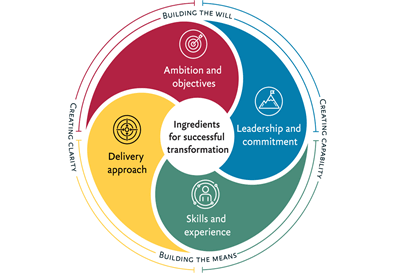Stakeholder management is more than just a box-ticking exercise
We all know that when delivering change across an organisation, we need to involve the people who have a stake in that change. Many of us are likely to have ‘stakeholder management’ in our plans. This typically includes activities such as identifying those people affected and their expected reaction; looking at how best to communicate with them and secure endorsement; managing expectations along the journey; and mitigating the risk of opposition.
However, there is a risk that in focusing on ‘managing’ our stakeholders – where the process may feel like it’s being ‘done to’ them – we miss the benefits of having them truly involved. This can result in poor ownership and poor outcomes.
The key differences between stakeholder management and stakeholder engagement
Perhaps, instead of stakeholder management, we should be thinking about stakeholder engagement? There are a number of key differences between the two approaches.
Co-developing ideas with stakeholders, not just communicating them
Firstly, stakeholder engagement involves working closely with the relevant individuals from the very outset of the initiative to co-develop ideas and solutions, rather than communicating ideas that have been pre-determined by the project team. You should consider the broad set of individuals and interest groups within the organisation to achieve this.
Collective rather than individual working
Secondly, bringing individuals and groups together collectively, rather than picking them off one by one, can create richer conversation, highlighting issues that may otherwise not be covered or benefits that may not have been identified.
Stakeholder engagement provides a tailored approach
Terceiro, simplesmente mudando a ênfase do "gerenciamento" para o "engajamento", é mais provável que você se concentre no que as pessoas diferentes precisam se sentir verdadeiramente envolvidas, incentivando uma abordagem mais atenciosa e personalizada. As soluções têm maior probabilidade de serem adotadas e podem durar mais tempo.
True engagement of stakeholders can lead to the development of more successful, innovative solutions that have broader and stronger ownership, as well as better appreciation of why the change is needed. The solutions are more likely to be adopted and may well last longer.
Fostering Trust
Essa abordagem tende a ser usada ao fornecer alterações no setor público. Por exemplo, o NHS possui um conjunto complexo e variado de partes interessadas, incluindo conselhos locais, médicos e profissionais de diferentes organizações e setores, pacientes, formuladores de políticas e público em geral. É extremamente importante (e, em alguns casos, legalmente exigido) que os diversos grupos estejam envolvidos desde o início para destacar desafios e desenvolver soluções em conjunto. Essa é uma maneira crucial de garantir que todas as partes adotem as alterações entregues.
Isso é igualmente aplicável ao setor privado. Por exemplo, w quando um grande banco do Reino Unido adquiriu uma conhecida sociedade de construção, a intenção era substar a marca desde o primeiro dia. No entanto, após uma série de grupos focais com os clientes, o banco alterou seus planos, manteve a marca e impediu o grande número previsto de clientes de mudar seus negócios para um banco alternativo ou sociedade de construção. As organizações estão se tornando mais conscientes do ambiente em que operam e do impacto que isso tem sobre elas. Existem
Preparing for the challenges
So why is this relevant to your business? Organisations are becoming more aware of the environment in which they operate and the impact it has on them. There are Expectativas maiores para demonstrar responsabilidade social corporativa, e a crescente demanda por transparência torna as organizações mais responsáveis pelo público. Mais pessoas têm uma opinião e querem dizer sobre como uma organização é executada.
, mas os mesmos princípios também se aplicam à maneira como envolvemos as pessoas internamente. Pode parecer mais exigente ou mais desconfortável; O resultado pode não ser o que você esperava. As partes interessadas podem ser inicialmente cínicas e requer mais tempo e esforço de sua parte. Não tenha medo de envolvê -los na identificação dos problemas e na definição das soluções, em vez de dar a eles sua visão da resposta. Reconheça que você não tem as soluções, mas deseja que a ajuda deles as desenvolva
For the successful delivery of large-scale change, you have to get genuine buy-in and involvement from different parts of the organisation, its functions, and often its regions as well.
So what are the challenges that come with this approach? It can feel more demanding or more uncomfortable; the result may not be what you expected. Stakeholders may be initially cynical, and it requires more time and effort on your part.
Factors to consider when engaging stakeholders include:
- Be bold – think broadly about who you could engage and how bringing different groups together may be of benefit. Don’t be afraid to involve them in identifying the issues and defining the solutions, rather than giving them your view of the answer. Acknowledge that you don’t have the solutions, but want their help to develop them
- Esteja preparado - Certifique -se de configurar discussões produtivas, entendendo percepções, interesses e expectativas antecipadamente. Seja claro sobre os resultados pretendidos ao reunir as pessoas e pense em formatos e locais inovadores nos quais isso pode ser alcançado
- tem uma forte facilitação - Gerencie sessões eficazmente, resolvendo conflitos e mal -entendidos, adaptando a abordagem necessária e incentivando e incentivando as soluções que se beneficiam de todos os anos. Procure alcançar um acordo comum sobre as saídas. Por exemplo, tente chegar a um consenso sobre objetivos, objetivos, prioridades e ações mútuos. Mantenha as partes interessadas informadas sobre o progresso. Ao fazer isso, você garantirá resultados eficazes, bem -sucedidos e duradouros em toda a sua organização. Parceiro
- Establish a common vision – aim to achieve common agreement on the outputs. For example, try to come to a consensus on mutual objectives, goals, priorities and actions.
- Show you have listened – acting on and responding to what you have heard builds trust and confidence. Keep the stakeholders informed about progress.
Lasting results
So when embarking on significant change, make sure that the emphasis is on active stakeholder engagement rather than just passive management. In doing so you will ensure that you deliver effective, successful and lasting results across the whole of your organisation.












